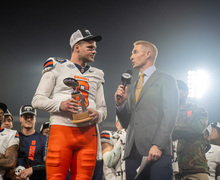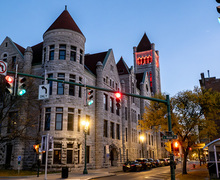March Madness darling Tobin Anderson began turning programs around at Le Moyne
Courtesy of St. Thomas Aquinas College Athletics
Iona head coach Tobin Anderson, who previously served as an assistant at Le Moyne, rose to national prominence when Fairleigh Dickinson upset No. 1 Purdue.
Get the latest Syracuse news delivered right to your inbox. Subscribe to our sports newsletter here.
Former Le Moyne guard Brett Doody received a text from Michael Culley on the night of March 15 telling him to turn on his television and check out a former coach of theirs. He hadn’t heard the name Tobin Anderson in 20 years. Doody flipped through the channels until he found Fairleigh Dickinson’s First Four matchup with Texas Southern. The two 16 seeds, vying for a chance to play No. 1 Purdue in the NCAA Tournament. Patrolling the sidelines and screaming commands was Anderson. He was slightly greyer with bigger bags under his eyes and had swapped a button-down shirt and striped tie for a black FDU quarter zip.
“Holy mother of God. There he is: Tobin Anderson,” Doody said.
It was the same Dolphins assistant coach who’d worked with Doody and the Le Moyne guards on their ball-handling skills during practice. Anderson easily related to his players, whether it was riling them up or flashing his shooting abilities after each session. His fiery energy helped jolt the Dolphins into playing at what Doody felt like was their best basketball.
Doody and other teammates at the time never felt Anderson, then 25 years old, would make the jump to Division I, let alone take over a tournament-winning team. Not many did. Former Le Moyne head coach John Beilein had successfully completed the transition but others experienced the leap from Division II with limited success. They remember Anderson as an energetic assistant coach, hungry for the chance to turn around a program who had the charisma to get every ounce of talent out of his players. Twenty-six years later, his former Le Moyne players watched as he led Fairleigh Dickinson to one of the most miraculous upsets in NCAA Tournament history.
“Players play for him. That’s really what it comes down to,” Doodby said. “They work hard for him because he sees the talent of these kids. He just gets kids to play.”
Before that, was a 10-month turnaround, where Anderson took a program that won just four games the year prior, to the Northeast Conference Championship game against Merrimack. The Knights lost out to the Warriors but Merrimack was deemed ineligible for the NCAA Tournament, in the midst of its four-year waiting period after reclassifying to Division I. So, FDU advanced to the play-in game, taking out Texas Southern to set up a meeting with No. 1 Purdue.
Before Fairleigh Dickinson pulled off arguably the largest upset in NCAA history and played Florida Atlantic to the brink for a shot at the Sweet 16, Anderson was simply an energetic coach trying to make a name for himself in central New York.
A youthful counterpart to the then-head coach Dave Paulsen steady hand leading the Dolphins, Anderson, after two seasons as an assistant at Clarkson, primarily worked with guards at Le Moyne. Just a few years removed from his playing career at Wesleyan College, Anderson, and his “gym rat” persona, helped relate to his players. It was enough evidence for Clarkson to bring him back as a head coach, his first of three programs he’d morph into league powerhouses in less than just as many years.
Then, just days after the Cinderella run ended with a 78-70 loss to FAU, he accepted the head coaching job at Iona, replacing Hall of Fame coach Rick Pitino. Most people wouldn’t want to fill the shoes of one of college basketball’s best coaches, former Wesleyan assistant coach Edward Quick said. But, Anderson lept at the opportunity, eager to continue his career with a mid-major powerhouse.
“Everything that you just saw on TV all weekend long, is exactly what Tobin is like,” former Le Moyne center Alex Harris said.
The son of a prominent high school basketball coach in Iowa and South Dakota. Anderson’s father, Steve, wanted him to get national attention — possibly from an Ivy League school — at the next level. He knew Anderson was good, but recognized the lack of attention for Truro, Iowa, a town that now has a population of just 509. Steve sent Anderson to Maine Central Institute, a preparatory school, to play under Max Good. Anderson was a “tremendous” shooter, Quick said. Quick, who was fresh off the culmination of his Division-III college playing career, met with head coach Herb Kenny and the rest of Wesleyan’s staff to go over the incoming recruiting class.
“We got this shooter from Iowa. I don’t know if he can play any defense. Maybe you can teach him to play defense,” Quick recalls Kenny saying. Anderson was described as “quirky,” and as someone who could really shoot. Kenny said there was always room for shooters.
Anderson picked Quick’s brain for longer than any of the incoming freshmen had, peppering him with questions. The young coach began to think something was different with Anderson. It was clear his basketball IQ was high. Anderson continued to pester Quick and his teammates about practicing and playing pick up, especially in shooting competitions that Anderson tended to win. Quick was certain Anderson would end up being a coach.

Tobin Anderson is now the new head coach at Iona after a successful 10-month stint at Iona. Courtesy of St. Thomas Aquinas College Athletics
“This happens by years and years of shaping who you are,” Quick said. “He was born to be a coach.”
Quick kept a close eye on Anderson’s ascent to national darling. First at Clarkson, then Le Moyne, Hamilton, Siena and St. Thomas Aquinas. Each time, Quick noticed the team’s high-powered, fast-paced approach — the same characteristics he would eventually see in FDU’s upset of Purdue. When the Knights took on Central Connecticut State on Jan. 14, Quick was in attendance to watch Anderson — his two-year captain at Wesleyan who finished with the 11th-most points in program history.
Fairleigh Dickinson beat CCSU 88-80, grabbing its fifth victory of an eventual six-game winning streak midseason to help earn the No. 2 seed heading into conference tournament play. Anderson had brought with him four players from Division-II St. Thomas Aquinas to FDU, meshing them with a returning roster that produced 13 wins over the last two seasons. He just made it work, Quick said, and approached his old player after the game.
“We got a chance to be in the mix in the league,” Quick remembers him saying. “We’re just trying to get better every day.”
The full-court pressing and defense-heavy CoachTube videos were a surprise to Quick, who knew Anderson to be a struggling man-to-man defender. But, Anderson’s teams fed off of his high energy.
Former Dolphins guard Jakup Hrabovsky said that when he played under Anderson, he saw a young coach “in transition.” He could still flash his handles and drill most free throws, but began to teach, rather than show, what made him so successful. Hrabovsky, who came to the United States from the Czech Republic, needed time to catch up to the faster-paced, more physical American game. Anderson worked one-on-one with him and Hrabovsky credits Anderson for helping him improve into one of Le Moyne’s top players in 1998.
The Dolphins would play shooting games to warm up before practice and games. Anderson often participated. Teams of two players — one including Harris and Anderson — would try from different spots on Ted Grant Court to make as many shots as they could in 30 seconds. Harris said that he — the center — and Anderson — the assistant coach — used to win most of the time. Anderson would set up metal chairs on the free-throw lines and instruct his guards to weave and dribble in between them. Then, after practice, he’d go to Le Moyne’s gym and work out with the players.
“He went beyond his professional duty,” Hrabovsky said. “He was always there for you … through our ups and downs on and off the court.”
Anderson fit the mold of the current state of college basketball from the beginning, one that hinges on player empowerment and attacking the transfer portal. It was the perfect combination for Anderson to become a nationally-recognized coach. As a player, Anderson worked with his father to earn a spot on Wesleyan’s team. From there, he developed over four years, going from an undersized shooter to one of the most decorated scorers in school history.
“This happens by years and years of shaping who you are. He was born to be a coach.former Wesleyan assistant coach Edward Quick
Under Paulsen, he became a reliable coach, motivating Le Moyne to a 33-22 record in his two seasons as assistant. Anderson evolved and took over at Clarkson, submitting a 67-66 record through five seasons, including a Liberty League record of 33-35.
Then, he advanced to Hamilton, turning the Continentals from one of the worst in the Liberty League to a three-time regular season champion and a D-III NCAA Tournament team.
A short stint at St. Thomas Aquinas and one unforgettable year at Fairleigh Dickinson rounded out Anderson’s journey before he signed a five-year contract with Iona. The Knights were the shortest team in Division-I basketball. They were just the second-ever No. 16 seed to advance. It must’ve been the coaching.
“Great guy that you want to cheer for,” Harris said. “The reason that the whole country got behind him and cheered for him is because that’s the kind of person he is.”

Published on March 24, 2023 at 9:41 pm
Contact Anthony: aalandt@syr.edu | @anthonyalandt





